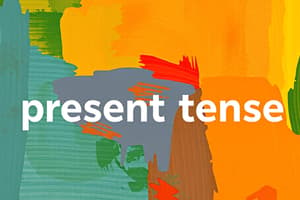Podcast
Questions and Answers
การใช้คำว่า 'does' ในฐานะกริยาเป็นอย่างไร?
การใช้คำว่า 'does' ในฐานะกริยาเป็นอย่างไร?
- ใช้เพื่อสร้างคำถามและการปฏิเสธในอดีต
- ใช้กับประธานที่เป็นพหูพจน์
- ใช้กับประธานที่เป็นเอกพจน์ในปัจจุบัน (correct)
- ไม่มีการใช้งานในประโยคทั่วไป
คำใดต่อไปนี้มีความหมายเหมือน 'ช่วยเหลือซึ่งกันและกัน'?
คำใดต่อไปนี้มีความหมายเหมือน 'ช่วยเหลือซึ่งกันและกัน'?
- Do someone a favor (correct)
- Do the trick
- Do one's best
- Do away with
คำถามใดที่ถูกต้องเกี่ยวกับการใช้ 'did'?
คำถามใดที่ถูกต้องเกี่ยวกับการใช้ 'did'?
- ใช้เพื่อระบุการกระทำที่เสร็จสิ้นในอดีต (correct)
- ใช้ในประโยคที่เป็นการปฏิเสธในปัจจุบัน
- ใช้ในประโยคอนาคต
- ใช้เฉพาะกับบุรุษที่หนึ่ง
ในประโยค 'I do like ice cream' คำว่า 'do' ถูกใช้เพื่ออะไร?
ในประโยค 'I do like ice cream' คำว่า 'do' ถูกใช้เพื่ออะไร?
'Do not' ใช้ในบริบทใด?
'Do not' ใช้ในบริบทใด?
สำหรับประโยคไหนที่ใช้ 'does not' อย่างถูกต้อง?
สำหรับประโยคไหนที่ใช้ 'does not' อย่างถูกต้อง?
Flashcards are hidden until you start studying
Study Notes
Present Tense Usage
- Forms:
- Base form: do
- 3rd person singular: does
- Usage:
- Used to express actions or general truths.
- Example: "I do my homework every day."
- Example: "She does not like coffee."
Common Idiomatic Expressions
- Do one's best: To try as hard as possible.
- Do the trick: To achieve the desired effect.
- Do away with: To eliminate or abolish something.
- Do someone a favor: To help someone out.
Questions And Negations
- Questions:
- Used as an auxiliary verb to form questions.
- Example: "Do you like pizza?"
- Example: "Does he play the guitar?"
- Negations:
- Formed using "do not" (don’t) or "does not" (doesn’t).
- Example: "I do not understand."
- Example: "She does not want to go."
Past Tense Forms
- Forms:
- Simple past: did
- Negative: did not (didn’t)
- Usage:
- To indicate actions completed in the past.
- Example: "I did my homework yesterday."
- Example: "They did not finish on time."
Role In Auxiliary Verbs
- Function:
- "Do" serves as an auxiliary verb to form questions and negations in the present simple tense.
- Examples:
- Questions: "Do you know the answer?"
- Negations: "I do not agree."
- Emphasis: Used to add emphasis in affirmative sentences.
- Example: "I do like ice cream."
การใช้กริยาช่องปัจจุบัน
- รูปแบบ:
- รูปพื้นฐาน: do
- รูปเอกพจน์ที่ 3: does
- การใช้งาน:
- ใช้ในการแสดงการกระทำหรือความจริงทั่วไป เช่น "I do my homework every day."
- ประโยคตัวอย่าง: "She does not like coffee."
สำนวนที่ใช้บ่อย
- ทำให้ดีที่สุด: พยายามอย่างเต็มที่
- ใช้ได้ผล: ทำให้ได้ผลตามที่ต้องการ
- กำจัดบางสิ่ง: ลบหรือยกเลิกบางอย่าง
- ทำอะไรให้ใคร: ช่วยเหลือผู้อื่น
คำถามและการปฏิเสธ
- คำถาม:
- ใช้เป็นกริยาช่วยในการสร้างคำถาม เช่น "Do you like pizza?"
- ตัวอย่าง: "Does he play the guitar?"
- การปฏิเสธ:
- ใช้ "do not" (don’t) หรือ "does not" (doesn’t) เช่น "I do not understand."
- ตัวอย่าง: "She does not want to go."
รูปแบบของกริยาช่องอดีต
- รูปแบบ:
- อดีตธรรมดา: did
- รูปปฏิเสธ: did not (didn’t)
- การใช้งาน:
- ใช้เพื่อบ่งบอกการกระทำที่เสร็จสิ้นในอดีต เช่น "I did my homework yesterday."
- ตัวอย่าง: "They did not finish on time."
บทบาทในกริยาช่วย
- ฟังก์ชัน:
- "Do" ทำหน้าที่เป็นกริยาช่วยในการสร้างคำถามและการปฏิเสธในรูปแบบปัจจุบัน
- ตัวอย่าง:
- คำถาม: "Do you know the answer?"
- การปฏิเสธ: "I do not agree."
- การเน้นความสำคัญ: ใช้เพื่อเพิ่มน้ำหนักในประโยคยืนยัน เช่น "I do like ice cream."
Studying That Suits You
Use AI to generate personalized quizzes and flashcards to suit your learning preferences.




